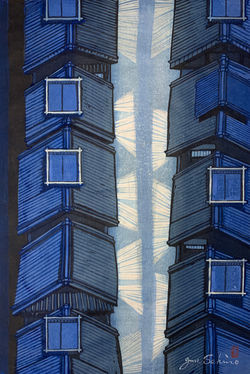JUNICHIRO SEKINO (1914-1988)
 "Bird's Eye View of Ponto-Cho"30 1/4" x 28 3/8", Woodblock 81/128 11155 |  "Hara Rooftile Reflection of Mt. Fuji"16 3/4" x 21 1/2", Woodblock 11191 |
|---|
Junichiro Sekino (1914-1988)
Junichiro Sekino was born in 1914 in Aomori. His father was a merchant of agricultural products, but from a young age he had an interest in the arts. He began to study printmaking and oil painting. Thankfully his was not alone in his interests, young Junichiro grew up in Aomori City together with Shiko Munakata. Munakata, who would later become the 'Japanese Picasso', might have been the artist who solidified the enthusiasm of art in young Sekino.
In 1936, Sekino won a prize at Bunten for one of his etchings. At this time, Bunten was part of the official government controlled art scene that had juries who decided on the admission of artworks. Being accepted to these official exhibitions was not easy. And much less, winning a prize was even more remarkable for the young artist.
This gave him enough momentum to move to Tokyo in 1939. He met and studied under Koshiro Onchi, the great mentor of the sosaku hanga art movement. This movement is known for the combination of Western techniques and subject matter, that created a specific style of its own. Junichiro adopted the techniques, but combined it with Japanese subjects- this made his work extremely unique.
To that end: his art training Sekino taught both the Japanese woodblock method, and Western techniques like etching. Although he had attended art training, Sekino was basically self-taught, as his method was so specific. His great inspirations were the old Japanese and European masters - Sharaku, Hiroshige and Toulouse Lautrec, Rembrandt and especially Albrecht Dürer.
World War II was on its way, and it resulted in very unfortunate circumstances for Japanese artists. Especially for printmakers, whose success and livelihood often depended on art exports to Western countries as the major foreign market for Japanese prints.
Other means of income became necessary, so Sekino got work in an ammunition factory. Even the most basic resources for printmaking like paper or ink were rationed, which made it impossible to work. Art production came to a virtual standstill for Japanese artists in 1940-1945.
Thankfully this lull didn’t last long, because after 1945 Junichiro slowly began to make his way to international fame. The next few years picked up pace slowly, as he made a living with book illustrations.
But the artist's big breakthrough came in the 1950s. In 1953 he had his first one-man show in Tokyo. The success led to his work being shown at international exhibitions outside Japan like the Print Biennials in Lugano, Switzerland.
International museums like the MOMA (Museum of Modern Art) in New York, The Boston Museum of Fine Arts or the Bibliothèque Nationale in Paris began to collect his prints as well.
As his success spread, his work became more sought after. This led to an official invitation by the Rockefeller Foundation and the American Japan Society to come to the United States for the first time. This was in 1958. From then on follows a long list of international exhibitions, prizes and frequent travels to Northern and Southern America and Europe.
His success was welcome but he desired a quiet life, so he began to teach. In 1963 Sekino taught printmaking at Oregon State University, where he is still regarded as one of the most influential teachers at that school.
He continued on creating and teaching for many years, and passed away in 1988.
Biography adapted from the Artelino biography.

